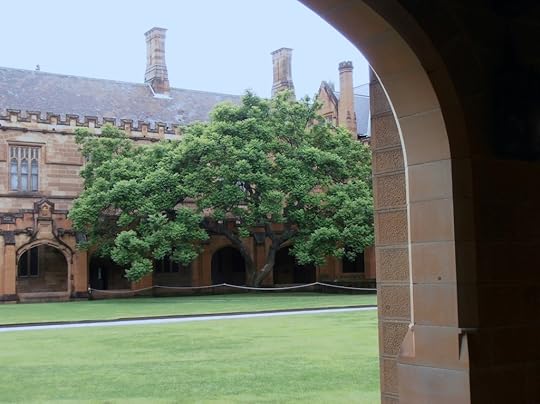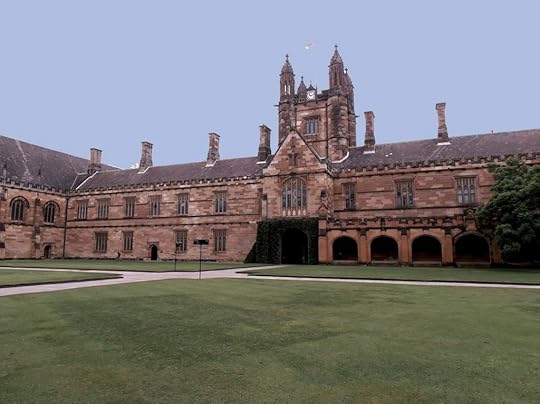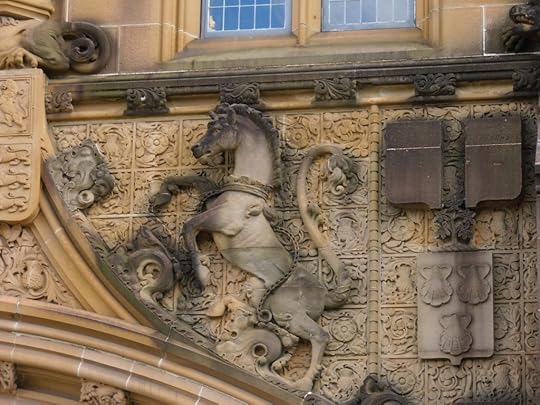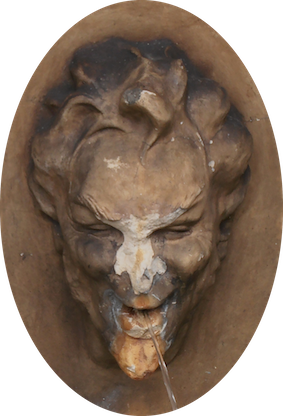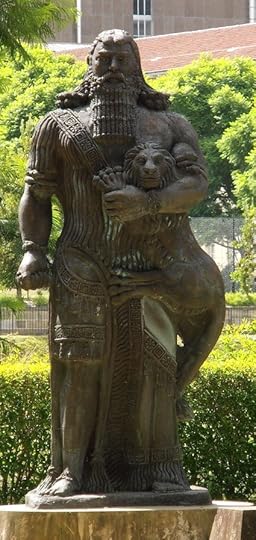Michelle Cooper's Blog, page 32
February 17, 2012
In Which I Take More Photographs
Yesterday, I posted some photographs of a Lion and a Unicorn. Here's where they live:
They're over the southern entrance to the Main Quadrangle of the University of Sydney, which is Australia's oldest university. On the left side of the photo you can see part of MacLaurin Hall, the original university library. Here's another view of MacLaurin Hall:
I sat for exams in that building a couple of decades ago. (I blame the extremely distracting neo-Gothic architectural details for my poor results.)
If you walk through the Lion and the Unicorn entrance, you'll find yourself in the Main Quadrangle, which features a beautiful jacaranda tree:
The tree is covered in vivid purple flowers in late spring. It's said that if you haven't started studying by the time the jacaranda flowers, you'll fail all your exams. Here's another view of the Main Quad, showing the Clock Tower and Carillon:
According to Tess van Sommers, who wrote the text of University of Sydney Sketchbook, "If architect Edmund Blacket had had his way, this tower would have had even more ornate turrets than it has now; some almost deliriously convoluted pinnacles were among his rejected designs."
At the left side of the photo, you can see a bit of the Great Hall, a "scaled-down version of Westminster Hall in London". At the moment, most of it is covered in scaffolding, so I didn't take a photo from the front, but it's a fairly spectacular edifice. Apparently, its construction in the 1850s and 1860s did not go smoothly, with workmen often abandoning the site to join the latest gold rush, while politicians kept raising doubts about "the need for such frivolities as gargoyles". Also, "for some years, the frontal majesty of the block was marred by an approach through cow pastures" and what is now Victoria Park featured a dam in which horses bathed and occasionally died.
But what, you may ask, does all this have to do with my current writing project? Good question. I don't have a very detailed answer yet, but wait and see. It's possible that something interesting and historical and book-shaped will (eventually) appear.
February 16, 2012
In Which I Take Some Photographs
Last month I bought my very first camera, so that I could take some photos of the setting of my next novel. This work-in-progress doesn't even have a title yet. All I've done so far is read a lot of books about the subject, fill a folder with research notes and think up some fairly silly jokes and snippets of dialogue. The next step – organising all of this into some sort of coherent plot – seems so overwhelming that I've been avoiding it. However, today I decided to go for a long walk around the place in which the novel is set, in the hope that this would inspire me to do some work. I took my camera along and here are some of the results.
First, the Lion:
His ferocity is slightly diminished by the fact that a few of his front teeth have fallen out. Actually, I'm not sure if the Lion is going to make it into my book, but the cute little gargoyle in the top left corner of the picture definitely is.
And then, the Unicorn:
I'm assuming it is a Unicorn (and not just a horse with a weird lump on its forehead), because it's helping the Lion hold up a coat of arms. Poor Unicorn has lost most of its horn, but hey, if you were a hundred and fifty years old, bits of you would probably be falling off, too.
Next is Mephistopheles, spitting into a fountain:
Unfortunately, he's missing most of his nose, but he still looks quite evil. He was (supposedly) designed by Australian architect Leslie Wilkinson in 1925, and possibly inspired by Australian artist Norman Lindsay. (I accidentally typed 'Normal Lindsay' just then, which I'm sure he would have found highly insulting.)
And then there's Gilgamesh, who is either hugging or strangling a lion:
I have to admit that I don't yet know much about Gilgamesh, except that he was the king of Uruk (now Iraq and Kuwait) in about 2500 BC and was regarded as a demigod in Mesopotamian mythology. He also went on a 'quest to seek immortality', which is very useful for my purposes. I'm choosing to believe he is embracing the lion, even though the lion doesn't look very happy, because Gilgamesh also found 'compassion, friendship, courage, love and peace' on his quest. That's nice, isn't it?
Tomorrow: More photographs from my expedition, and I'll explain where you can find Gilgamesh and his friends. (Shh, Sydneysiders, I know you've already worked out where the photographs were taken! But I'm trying to create some suspense here!)
February 7, 2012
FitzOsbornes at War Excerpt And Other Exciting Things
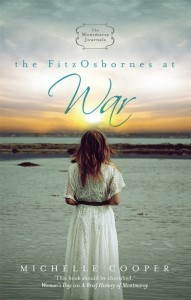 I've just done a bit of work on my author website – given it a fresh coat of paint, swept the floors, polished the windows, that sort of thing. Oh, and I've also added a new annexe and arranged some shiny new articles on the shelves. There's a photograph of the cover of my new book. There's an excerpt from the book. There's a bit of historical background information for readers who'd like to know more about England during the Second World War. There's even a set of free downloadable Teaching Notes for the novel, if you happen to be a teacher, although the Teaching Notes won't be available until the book is released in April.
I've just done a bit of work on my author website – given it a fresh coat of paint, swept the floors, polished the windows, that sort of thing. Oh, and I've also added a new annexe and arranged some shiny new articles on the shelves. There's a photograph of the cover of my new book. There's an excerpt from the book. There's a bit of historical background information for readers who'd like to know more about England during the Second World War. There's even a set of free downloadable Teaching Notes for the novel, if you happen to be a teacher, although the Teaching Notes won't be available until the book is released in April.
Gosh, two blog posts in twenty-four hours. I don't know what's come over me. It must be all the excitement of having a new book out in seven weeks.
February 6, 2012
'Dated' Books, Part Five: Emil and the Detectives
'Dated' doesn't have to mean 'painful to read' – sometimes it can mean 'charming and sweet and nostalgic'. Emil and the Detectives, written by Erich Kästner in 1929, is an example of a children's adventure story that is old-fashioned in the best sense of the word. Young Emil (age unknown, but he seems to be about ten or eleven) encounters a suspicious bowler-hatted man during a journey to Berlin. While Emil is asleep in the train carriage, the man steals a large sum of money that Emil is meant to deliver to his grandmother. Emil doesn't feel he can report it to the police – he's already afraid that he's going to be arrested because he chalked a red nose and black moustache on an important statue in his home town. No, Emil must track down the missing money himself in Berlin. It's a daunting task for a country boy – but luckily he encounters Gustav and his gang of friends, who are eager to be part of the adventure.
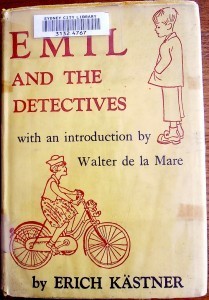 Ah, the good old days – when rural mothers sent their young sons off on unaccompanied, four-hour train trips to an unfamiliar city, and city parents allowed their boys to roam the streets of Berlin in the middle of the night. Unfortunately, they were also the days when girls weren't allowed to have adventures. Emil's female cousin, Pony, would love to help, but all she can do is bring refreshments to the boy detectives. On the few occasions she gets to speak, she says things like "I wish I could stay! I'd make you some coffee. But I can't, of course. Nice girls like me have to be in bed in good time" and "I'm just doing the washing up. Women's work is never done". I'd love to have seen Pony run down the thief on her bicycle or something. Still, the boys – Gustav with his motor horn, the bespectacled Professor, little Tuesday and the rest – are so full of energy, fun and ingenious plans that the story skims along. It's also nice to see a boy character who cares for his mother in lots of practical ways and isn't afraid to discuss this with his new friends (although Emil does threaten to punch anyone who calls him a mummy's boy).
Ah, the good old days – when rural mothers sent their young sons off on unaccompanied, four-hour train trips to an unfamiliar city, and city parents allowed their boys to roam the streets of Berlin in the middle of the night. Unfortunately, they were also the days when girls weren't allowed to have adventures. Emil's female cousin, Pony, would love to help, but all she can do is bring refreshments to the boy detectives. On the few occasions she gets to speak, she says things like "I wish I could stay! I'd make you some coffee. But I can't, of course. Nice girls like me have to be in bed in good time" and "I'm just doing the washing up. Women's work is never done". I'd love to have seen Pony run down the thief on her bicycle or something. Still, the boys – Gustav with his motor horn, the bespectacled Professor, little Tuesday and the rest – are so full of energy, fun and ingenious plans that the story skims along. It's also nice to see a boy character who cares for his mother in lots of practical ways and isn't afraid to discuss this with his new friends (although Emil does threaten to punch anyone who calls him a mummy's boy).
I do wonder what today's young readers, accustomed to fast-paced modern adventure stories, would make of a book that begins with Mrs Wirth, the baker's wife, having her hair shampooed by Emil's mother. It takes a few chapters before anything remotely suspenseful or adventurous happens, although the action speeds up once Emil reaches Berlin. Young readers may also struggle with some of the dialogue, unless they're familiar with Enid Blyton. The edition I borrowed from my library was a 1959 English translation (see photograph above – although I must emphasise that Sydney City Library does stock other, more recent, children's books). Gustav says things like "Cheerio, Emil. Gosh, I'm looking forward to this. It's going to be smashing!" and the stolen 120 marks is translated into "seven pounds" (which still won't mean much to young readers). I think a modern translator might have done a better job of conveying the original German text, although I suppose it's always difficult to translate slang.
The edition I read also included a rather poignant introduction by Walter de la Mare which says, "There is nothing in it that might not happen (in pretty much the same way as it does happen in the book) in London or Manchester or Glasgow tomorrow afternoon." This may have been true when he wrote it in 1931, but it certainly wasn't ten years later. By that time, Britain and Germany were at war; the cities of Berlin, London, Manchester and Glasgow were being bombed; and young Emil and his friends were of age and probably conscripted into the Nazi war machine. Meanwhile, the author, a pacifist, had been interrogated by the Gestapo and had his books burnt by the Nazis. His home in Berlin was destroyed by bombs, but he survived the war to write more books for children and adults, including an autobiography called When I Was A Little Boy. Emil and the Detectives was made into several films, the most recent in 2001 (in which, apparently, Pony had a bigger role to play, hooray!).
Thank you, Alex, for drawing my attention to this book in one of your comments a few months ago. I think I might have read it as a child, but I had forgotten almost everything about it, so I thoroughly enjoyed all the plot twists and jokes.
More 'dated' books:
1. Wigs on the Green by Nancy Mitford
2. The Charioteer by Mary Renault
3. The Friendly Young Ladies by Mary Renault
4. Police at the Funeral by Margery Allingham
5. Emil and the Detectives by Erich Kästner
January 28, 2012
Careful, He Might Hear You by Sumner Locke Elliott
There's always a bit of trepidation when you re-read an old favourite from your teenage years. Will the book turn out to be No Good At All? Will it be obvious and sentimental and vacuous? Will it simply reveal that you used to have appalling taste in literature? Thankfully, Careful, He Might Hear You proved to be just as good as I remembered – perhaps even better, because I can now see the immense skill that went into the construction of its apparently effortless prose.
Careful, He Might Hear You was Sumner Locke Elliott's first novel. It was published in 1963, but he'd been writing plays, radio serials and television scripts for decades before that, and it really shows in his writing. He knew all about plot and pacing, how to balance action with introspection and how to reveal character through dialogue. But writing a novel also allowed him to write beautiful descriptions of a setting he knew very well, that of Sydney during the Depression. The novel is based on his own childhood, in which he was the focus of a bitter custody battle between several aunts. His mother, a popular Australian writer, had died giving birth to him and his father, an irresponsible alcoholic, played no part in his upbringing. On one side of the battle was his anxious, motherly Aunt Lillian (named 'Lila' in the book), the wife of a hard-working but poor Labor politician; on the other was rich Aunt Jessie ('Vanessa'), recently returned from England and determined to transform her nephew into a proper little gentleman. The situation was complicated by his odd Aunt Agnes, disciple of a bizarre American cult, and his bohemian Aunt Blanche ('Vere'). The author does a superb job of narrating events from the perspective of six-year-old PS, who is by turns amused, baffled and angered by the grown-ups running his life. It's a pleasure to watch him slowly gain some control over the adults, although the author also manages to evoke some sympathy for them. There is poor, over-worked Lila; her long-suffering husband, George; emotionally-repressed Vanessa; even exuberant Vere is revealed to have hidden sorrows. There are also gorgeous descriptions of Sydney in the 1930s – a cruise liner steaming into Sydney Harbour, a train trip to dusty Woronora Cemetery, Lila's suburban backyard and Vanessa's Point Piper mansion and Vere's chaotic flat in King's Cross:
"Vere poured the golden-coloured bubbles into two peanut butter glasses and handed one to Opal. They immediately forgot him and began talking about their friends who were all in a mess, thwarted, broke, maddened or suicidal, my dear. They had wonderful names like Dodo, Ukelele, Widget and Gussy. When they came to visit Vere, they brought her old shoe buckles, brooches, half-used pots of cold cream, combs and long, cool bottles because they were always dying of thirst, just dying of thirst, my dear, and their voices would grow brighter as the daylight faded, would fly around the small room like birds let out of cages telling about gay-sounding things, about parties and dancing, full of mysterious words that had to be spelled out in Lila's house and which made his heart jump for the time when he would understand and be a part of the things they told about with such laughter."
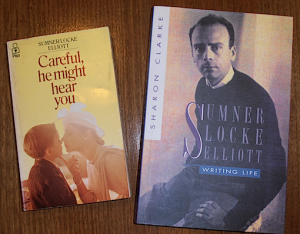
'Careful, He Might Hear You' by Sumner Locke Elliott and 'Sumner Locke Elliott: Writing Life' by Sharon Clarke
Careful, He Might Hear You was a huge success in the United States, Britain and Germany, but didn't sell very well in Australia, as Sumner Locke Elliott explained:
"I distinctly remember that [his agent] told me 50,000 copies had already been sold in Germany, where there had been three editions in six months, and naturally I was elated. Then I asked about Australia and she said, 'Seven.' And I said, with some delight, 'Well, 7,000, that's not bad at all – it's only a small country.' But she said, 'Not 7,000, just seven – seven copies.' And you know, I just couldn't believe it – my own country and only seven copies!"
Actually, it wasn't his own country by then, because he'd moved to the United States in 1948, escaping a country that had banned his plays and had little tolerance for gay men. He lived in Los Angeles, and then New York, where he died in 1991. Several of his novels (Waiting for Childhood, Eden's Lost and Water Under the Bridge) revisit the autobiographical themes of Careful, He Might Hear You, but it is his final novel, Fairyland, that's probably the closest to his real life. Fairyland is the depressing tale of a young man growing up in Australia, desperately ashamed of his desires for other men but longing to find true love. It includes scenes taken from the author's life, such as when he was bashed nearly to death in Wynyard railway station, and it shows the conservatism, violence and hypocrisy of the country where he grew up. Sharon Clarke wrote a good biography called Sumner Locke Elliott: Writing Life, which I recommend for anyone wanting to know more about the story behind Careful, He Might Hear You. There's also an excellent film version starring Robyn Nevin and Wendy Hughes, which came out in 1983. (At least, I remember liking it when I saw it, but that was a very long time ago. It is possible I had terrible taste in movies then.)
Anyway, I was very pleased to see that Text is bringing out a new edition of Careful He Might Hear You as part of its Australian Classics series. This book deserves to find lots of new readers.
January 17, 2012
In Which I Acquire Two Shiny New Things
Last week, I acquired two shiny new things. The first was a shiny new camera. I've never owned a camera before (no, not even one in a mobile phone, because I've never owned a mobile phone, either), so this has been a very exciting and time-consuming experience for me (hence the lack of blogging). Oh, the wonders of modern technology. This camera can do anything – it even has a MAGIC shooting mode. Unfortunately, I am a Muggle, so most of the magic has eluded me. This is particularly disappointing because one of the MAGIC modes can cause objects to sparkle. This immediately made me want to go around taking pictures of people, then showing them the photos and saying, 'LOOK! You're a sparkly vampire!', but so far, the only thing I've managed to turn into sparkles is a picture frame. However, I will persist. I actually bought the camera so I could take photos of the setting of my next book (which is set in Sydney, where I live), so those photos may appear on this blog in the near future. Or not, depending on how my photography skills develop.
The other shiny new thing I acquired was the Uncorrected Bound Proof (or ARC, if you're American) of my new book, The FitzOsbornes at War, which looks like this:
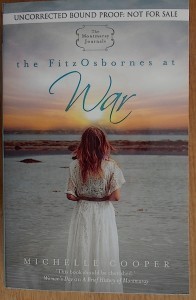
Click on the image to see the cover more clearly
Pretty, huh? I tried to make it sparkle, but all that happened was that a red splodge with an uncanny resemblance to a lobster claw appeared on Sophie's frock. (Oh, camera, sometimes I doubt your commitment to Sparkle Motion.) Here's a photo of the spines of all three Montmaray books, so you can see how enormous the third book is:
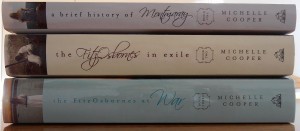
Click on the image to see the covers more clearly
Actually, it doesn't look much bigger than the second book, but it really is – it's more than five hundred pages. Massive. My next book's going to be a lot shorter.
Here, have a photo of a rainbow lorikeet:
January 5, 2012
FitzOsbornes at War Update
Australian edition of The FitzOsbornes at War
Copyedit of manuscript: Done!
Proofreading of 500+ pages of typeset book: Done!
Book cover: Done! (Although not by me.)
North American edition of The FitzOsbornes at War
Copyedit of manuscript: Done!
So, that was my holiday season! Hope you all had a lovely, relaxing break over the holidays and read some good books.
December 20, 2011
My Favourite Books of 2011
Okay, it's not the official end of the year just yet, but here's my list so far. It was a bit easier to compile than last year's list, because I now keep a book journal, which allows me to report the following statistics:
Number of books read so far this year: Fifty-seven (not including the two novels I disliked so much that I couldn't finish them)
Number of books read that I'd previously read: Seven (actually, there were more than seven, but I stopped noting them down in my journal, so most of them aren't included in this book tally)
Number of Young Adult books read: Fifteen
Number of children's books read: Eight
Number of memoirs read: Three
Number of other non-fiction books read: Nineteen
Number of graphic novels read: Three
Number of anthologies read: Two
Number of books by Australian writers: Fourteen
Number of books by British writers: Twenty-seven
Number of books by North American writers: Fourteen
Number of books by Scandinavian writers, translated into English: Two
Number of journals subscribed to this year: Two (Viewpoint on Books for Young Adults and Australian Author)
And now, here are the books I read this year that I loved the most. Note that none of them were actually published in 2011 (I'm still trying to catch up with reading from the nineteenth century).
Favourite Novel About Terrifying Creatures with Supernatural Powers
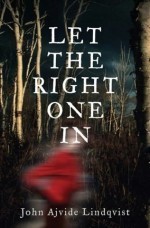 I don't read many horror novels – if I want horror, I can just read the newspapers. However, Let the Right One In by John Ajvide Lindqvist received a lot of favourable publicity when the two film versions were released, so I decided to give it a try and it was amazing. It's incredibly gruesome, but the author does such a terrific job of narrating events though each character (even a squirrel, at one point – truly) that I could not put the book down. I must say, it doesn't paint a very pretty portrait of late twentieth-century Sweden. Practically every character is desperately lonely, an alcoholic, a drug addict, mentally ill and/or a violent criminal, and yet all the modern-day villains (and there are many of them) have plausible reasons for their vile actions. Ultimately, it's a hopeful story about two outsiders helping one another. I should also note that this is one of the few translated novels I've ever read where the prose was completely seamless, as though it was originally written in English – the translator of the edition I read (whose name I forgot to write down) did a wonderful job.
I don't read many horror novels – if I want horror, I can just read the newspapers. However, Let the Right One In by John Ajvide Lindqvist received a lot of favourable publicity when the two film versions were released, so I decided to give it a try and it was amazing. It's incredibly gruesome, but the author does such a terrific job of narrating events though each character (even a squirrel, at one point – truly) that I could not put the book down. I must say, it doesn't paint a very pretty portrait of late twentieth-century Sweden. Practically every character is desperately lonely, an alcoholic, a drug addict, mentally ill and/or a violent criminal, and yet all the modern-day villains (and there are many of them) have plausible reasons for their vile actions. Ultimately, it's a hopeful story about two outsiders helping one another. I should also note that this is one of the few translated novels I've ever read where the prose was completely seamless, as though it was originally written in English – the translator of the edition I read (whose name I forgot to write down) did a wonderful job.
Favourite Novel About Victorian Clergymen
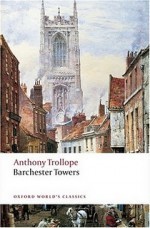 Barchester Towers by Anthony Trollope is a clever and very entertaining satire of church politics and middle-class English society – think Jane Austen with added snarkiness, or Charles Dickens without the sentimentality. I'm not sure who is my favourite villain – Mrs Proudie, self-appointed Bishop of Barchester, or the oleaginous Reverend Mr Slope, the chaplain who rapidly falls from grace after he gets tangled up in a few too many love affairs. There's also a good BBC television series based on this book and its prequel, The Warden, with Alan Rickman as Mr Slope.
Barchester Towers by Anthony Trollope is a clever and very entertaining satire of church politics and middle-class English society – think Jane Austen with added snarkiness, or Charles Dickens without the sentimentality. I'm not sure who is my favourite villain – Mrs Proudie, self-appointed Bishop of Barchester, or the oleaginous Reverend Mr Slope, the chaplain who rapidly falls from grace after he gets tangled up in a few too many love affairs. There's also a good BBC television series based on this book and its prequel, The Warden, with Alan Rickman as Mr Slope.
Favourite Short Story
'Different for Boys' by Patrick Ness (in Keith Gray's YA anthology, Losing It) is one of the best short stories I've read in years. Vibrant teenage characters, a school that felt completely authentic, real sex and real heartbreak, lots of jokes, all in forty-four pages.
Favourite Graphic Novel
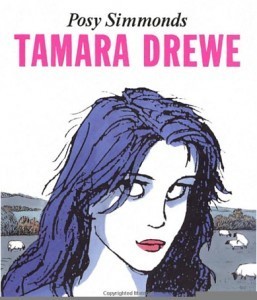 Admittedly, I only read three graphic novels this year, but Tamara Drewe by Posy Simmonds would probably have been my favourite even if I'd read fifty of them. It's a loose modern adaptation of Far From the Madding Crowd, set mostly in a writers' retreat in rural England. There's lots of biting satire about self-indulgent writers, academics, celebrities, middle-aged philanderers and 'liberated' young women, but the story is engrossing and includes a sad but realistic portrayal of disenfranchised rural teenagers. The art is great too, expressive without being too fussy (and is it just me, or does Glen, the American writer who's moved to England, look exactly like Bill Bryson?).
Admittedly, I only read three graphic novels this year, but Tamara Drewe by Posy Simmonds would probably have been my favourite even if I'd read fifty of them. It's a loose modern adaptation of Far From the Madding Crowd, set mostly in a writers' retreat in rural England. There's lots of biting satire about self-indulgent writers, academics, celebrities, middle-aged philanderers and 'liberated' young women, but the story is engrossing and includes a sad but realistic portrayal of disenfranchised rural teenagers. The art is great too, expressive without being too fussy (and is it just me, or does Glen, the American writer who's moved to England, look exactly like Bill Bryson?).
Favourite Book About Punctuation
Eats, Shoots and Leaves by Lynne Truss, which I have previously discussed here.
Favourite Children's Book
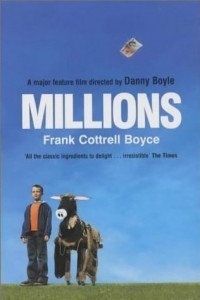 Millions by Frank Cottrell Boyce is the very best sort of children's story – funny, exciting and moving. A bag containing thousands of pounds lands in young Damian's lap, and he and his brother Anthony have only a couple of weeks to spend it before it loses all its value. They trigger hyper-inflation in the school yard, realise that material goods don't buy happiness, and discover that trying to do good in the world is harder than it seems (for example, when they give a large donation to the Mormon missionaries down the street, the men spend it on a dishwasher and foot spa). Damian's family are beautifully portrayed, but so are all the secondary characters – Damian's long-suffering teacher, the local policeman, a lady who visits their school to explain about the introduction of the Euro dollar, the various saints who appear as visions to Damian, even the robber trying to retrieve his stolen money. Highly recommended!
Millions by Frank Cottrell Boyce is the very best sort of children's story – funny, exciting and moving. A bag containing thousands of pounds lands in young Damian's lap, and he and his brother Anthony have only a couple of weeks to spend it before it loses all its value. They trigger hyper-inflation in the school yard, realise that material goods don't buy happiness, and discover that trying to do good in the world is harder than it seems (for example, when they give a large donation to the Mormon missionaries down the street, the men spend it on a dishwasher and foot spa). Damian's family are beautifully portrayed, but so are all the secondary characters – Damian's long-suffering teacher, the local policeman, a lady who visits their school to explain about the introduction of the Euro dollar, the various saints who appear as visions to Damian, even the robber trying to retrieve his stolen money. Highly recommended!
I must also mention two other children's books I enjoyed: The Secret Language of Girls by Frances O'Roark Dowell, about two best friends gradually growing apart during sixth grade, and Cicada Summer by Kate Constable, an intriguing time-slip story set in a drought-stricken Australian country town. (I also re-read From the Mixed-up Files of Mrs Basil E. Frankweiler by E. L. Konigsburg, which is still awesome.)
Favourite Book About Germs
I read quite a few 'popular science' books this year, some written by journalists, others by scientists, and I decided I much preferred the ones written by people who actually understood the science they were writing about. Anyway. Killer Germs: Microbes And Diseases That Threaten Humanity by Barry E. Zimmerman and David J. Zimmerman was a very clear, interesting account of the history of microbiology, with technical but accessible descriptions of how germs cause diseases. It did have an overwrought 'We're all doomed!' chapter about bioterrorism and antibiotic-resistant bacteria and so on, and the edition I read was out of date (published in 2003), but overall, it's very good. Also, it was written by science teachers who are identical twins (I'm not sure why the book pointed that out, but I couldn't help imagining them as looking like the Winkelvoss twins).
An honourable mention in the 'popular science' category (although this book is not specifically about germs) goes to Suckers: How Alternative Medicine Makes Fools Of Us All by Rose Shapiro, which examines a variety of 'alternative medicines' popular in the UK, ranging from chiropractic to homeopathy. The author points out that there is no scientific evidence to support most of these treatments, and she laments the money and time that the UK government devotes to 'quack remedies' that can be very dangerous (for example, chiropractic neck manipulations can cause strokes, and some herbal medicines contain toxic levels of lead and mercury).
Favourite Novel About Teenagers
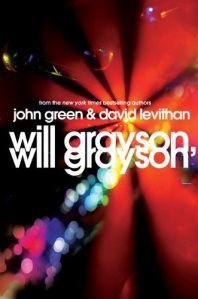 I really enjoyed Will Grayson, Will Grayson by John Green and David Levithan, a book about friendships between teenage boys – some gay, some straight, but all of them interesting, realistic characters. There was lots of humour and the story moved along at a perfect pace, but most importantly, it was emotionally resonant. I cried at the end, but I didn't feel manipulated into it by some sentimental epiphany on the part of the characters, because their emotional journeys seemed real. I also liked that while being gay wasn't 'normal' in this book, it wasn't the cause of unending angst, either. Maybe the girl characters could have been nicer or had more depth, but overall, I thought this was a great YA novel.
I really enjoyed Will Grayson, Will Grayson by John Green and David Levithan, a book about friendships between teenage boys – some gay, some straight, but all of them interesting, realistic characters. There was lots of humour and the story moved along at a perfect pace, but most importantly, it was emotionally resonant. I cried at the end, but I didn't feel manipulated into it by some sentimental epiphany on the part of the characters, because their emotional journeys seemed real. I also liked that while being gay wasn't 'normal' in this book, it wasn't the cause of unending angst, either. Maybe the girl characters could have been nicer or had more depth, but overall, I thought this was a great YA novel.
So . . . I don't seem to have read many new books this year – perhaps because I was so busy writing. I was reading online newspapers, magazines and blogs, but not that many books made out of paper (even though I don't own an e-reader, iPad or laptop, and my only internet connection is extremely slow dial-up). I do have a list of To Read books for 2012, but it's too long to type out, and I still haven't read a couple of books from my 2011 To Read list.
I hope that you've all had a great reading year, and that 2012 brings you many entertaining and intriguing books!
More Favourite Books of the Year:
December 8, 2011
I Hate Your Characters, So Your Book Stinks
Australian author Charlotte Wood recently wrote* about how she is troubled by readers who "seem to base the worth of a novel on whether or not they might be able to make friends with the characters in real life". She felt it was a sign of "laziness and immaturity" for readers to care about whether characters were "likeable", because the really important thing was "that the characters behaved convincingly, rather than pleasantly".
Ms Wood was talking about fiction for adults (for example, she refers to The Slap by Christos Tsiolkas and Jamaica by Malcolm Knox – both novels full of loathsome characters). However, I've also noticed a lot of bloggers reviewing Young Adult novels in terms of whether the main character is 'relatable'. I wasn't even aware that 'relatable' was a word until recently, and I'm still not entirely sure what it means in this context. Does it mean: 'I want to be friends with this character'? Or does it mean: 'I recognise something of myself in this character, even though the familiar characteristics may be flaws'?
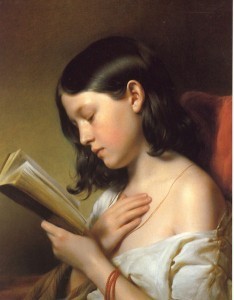 When I read fiction, I like to read about characters who are interesting. If I don't care about them, why should I keep reading to find out what happens to them? Sometimes I find characters interesting because they're likeable, but other characters are interesting because they're absolute monsters. For example, I love Mrs Proudie in Barchester Towers and Lady Montdore in Love in a Cold Climate – their very awfulness provides most of the comedy in those novels. My favourite example of an unlikeable narrator is Barbara in Zoë Heller's Notes on a Scandal. There is no way I'd ever want to be Barbara's friend, or even work in the same place as her, but her shrewd observations and general misanthropy make her wickedly perfect for her role in that novel.
When I read fiction, I like to read about characters who are interesting. If I don't care about them, why should I keep reading to find out what happens to them? Sometimes I find characters interesting because they're likeable, but other characters are interesting because they're absolute monsters. For example, I love Mrs Proudie in Barchester Towers and Lady Montdore in Love in a Cold Climate – their very awfulness provides most of the comedy in those novels. My favourite example of an unlikeable narrator is Barbara in Zoë Heller's Notes on a Scandal. There is no way I'd ever want to be Barbara's friend, or even work in the same place as her, but her shrewd observations and general misanthropy make her wickedly perfect for her role in that novel.
On the other hand, many of the novels I've loved reading have included likeable characters, and I don't think this is a sign that I am lazy or immature (although, of course, I can be both of these, at times). I'd much rather read Pride and Prejudice than Mansfield Park, for instance, because Lizzie is fun and smart and lively, whereas I just want to push Fanny Price off a cliff. Of course, 'likeable' doesn't mean 'perfect' – it simply means that I find the character's flaws natural, forgivable or amusing, rather than irritating.
This leads to the issue of whether authors ought to make their characters more likeable (or relatable), in order to attract more readers. I confess: when I started writing the Montmaray books, I deliberately tried to make my narrator likeable. I wanted her to be intelligent, good-hearted and have a sense of humour, and to learn from her mistakes. But one difficulty, especially with a series, is that if a character is perfectly likeable from the start, there is nowhere for her to go. How can she change and grow over time, if she starts off being wonderful? The other obvious problem is that just because an author thinks a character is likeable, doesn't mean that readers will agree. Some readers hated Sophie in A Brief History of Montmaray, describing her as stupid, childish and weak-willed. Just as we all have different reactions to real-life people, so we all like or dislike fictional characters to varying degrees. Perhaps, as Charlotte Wood suggests, all that authors can do is try to create characters who convey the messy truth of real life.
*Link to The Likeability Problem by Charlotte Wood (downloadable pdf) was found at this blog post in The Australian.
December 6, 2011
A Brief History of Montmaray Giveaway Winners
Thank you to all those readers who let us know about some of their favourite books. I Capture the Castle by Dodie Smith was a particular favourite, although there were also a couple of fans of Steve Kluger's My Most Excellent Year (which sounded like just my kind of book, until I read that it involved baseball). I must also agree with Maddy's description of the extreme creepiness of The Owl Service by Alan Garner. I haven't felt the same about owls (or plates with flower designs, or Welsh farms, for that matter) since I read it. I have added a few new books to my To Read list, and am seized with a desire to re-read Emil and the Detectives, which I think I read about thirty years ago.
Congratulations to Skye, Con and Sonia, who each won a signed copy of A Brief History of Montmaray.



